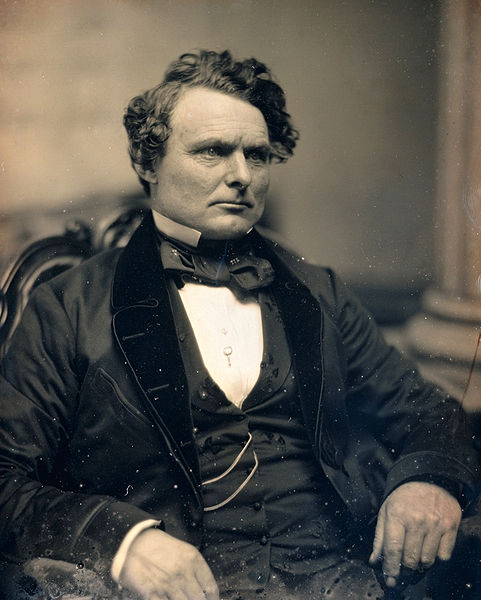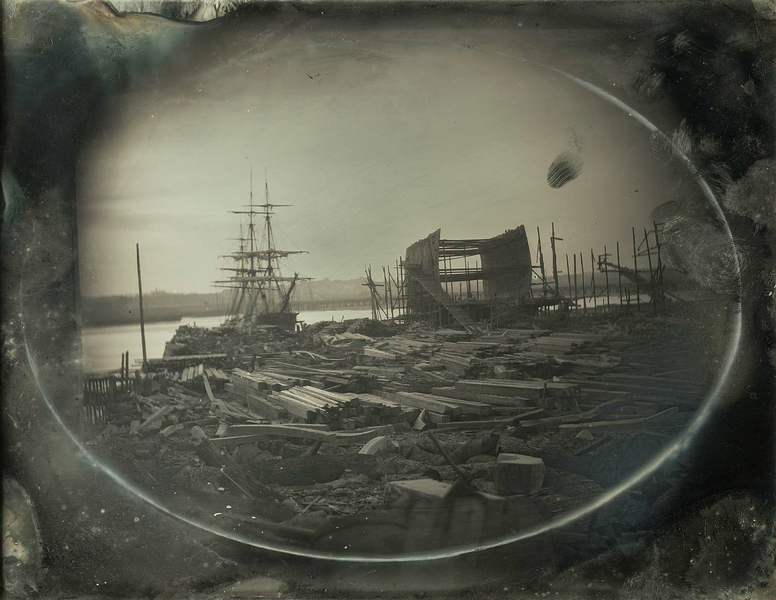<Back to Index>
- Ship Designer Donald McKay, 1810
- Painter and Sculptor Oskar Schlemmer, 1888
- President of Chile Manuel Francisco Antonio Julián Montt Torres, 1809
PAGE SPONSOR


Donald McKay (September 4, 1810 – September 20, 1880) was a Canadian born American designer and builder of sailing ships.
He was born in Jordan Falls, Shelburne County on Nova Scotia's South Shore. In 1826 he moved to New York, working for shipbuilders Brown & Bell and Isaac Webb. In 1841, he opened his first yard in Newburyport and moved to East Boston in
1845, building substantial packet ships for the Atlantic emigrant
route. McKay later designed and built some of the most successful clippers ever built. His house in East Boston is on the National Register of Historic Places. He was the great - great - grandfather of the American actor, author, and artist Gardner McKay (1932 – 2001).
McKay's
designs were characterized by a long, fine bow with increasing hollow
and waterlines as his career progressed. He was perhaps influenced by
the writings of John Griffiths, designer of Rainbow (1845),
an early China clipper. The long, hollow bow helped to penetrate rather
than ride over the wave produced by the hull at high speeds, reducing
resistance as hull speed is approached. Hull speed is the natural speed of a wave the same length as the ship, in knots,  ,
with LWL the waterline length in feet. His hulls had a shorter
afterbody, putting the center of buoyancy farther aft, than was typical
of the period, as well as a full midsection with rather flat bottom.
These characteristics led to lower drag at high speed compared to
contemporary ships of similar length, as well as great stability which
translated into the ability to carry sail in high winds (more power in
extreme conditions). His fishing schooner design was even more radical
than his clippers, being a huge flat - bottomed dinghy similar in form to
20th century planing boats.
These design changes were not favorable for light wind conditions such
as were expected on the China trade, but were helpful in the California
and Australian trades.
,
with LWL the waterline length in feet. His hulls had a shorter
afterbody, putting the center of buoyancy farther aft, than was typical
of the period, as well as a full midsection with rather flat bottom.
These characteristics led to lower drag at high speed compared to
contemporary ships of similar length, as well as great stability which
translated into the ability to carry sail in high winds (more power in
extreme conditions). His fishing schooner design was even more radical
than his clippers, being a huge flat - bottomed dinghy similar in form to
20th century planing boats.
These design changes were not favorable for light wind conditions such
as were expected on the China trade, but were helpful in the California
and Australian trades.
Pan Am named one of their Boeing 747s Clipper Donald McKay in his honor.
- Lightning set multiple records
- 436 miles in a 24-hour period
- 64 days from Melbourne, Australia, to Liverpool, England
- Sovereign of the Seas posted the fastest speed ever by a sailing ship - 22 kts. in 1854.
- James Baines logged a speed of 21 knots (June 18, 1856)
- Flying Cloud made two 89 - day passages New York to San Francisco
Between 1845 and 1850 McKay built five large packet ships for Enoch Train's White Diamond line, which specialised in the Atlantic emigrant route from Europe to North America. These were the Washington Irving, the Anglo Saxon, the Anglo American, the Daniel Webster, and the Ocean Monarch. The Ocean Monarch was lost to fire on 28 August 1848, soon after leaving Liverpool and within sight of Wales; over 170 of the passengers and crew perished. The Washington Irving carried Patrick Kennedy to Boston in 1849.
McKay is also probably the designer of two fishing schooners of an extreme clipper design, the Mary B. Dyer and H & R. Attwood.
During the American Civil War he was contracted by the US Navy to build the USS Nausett, one of the few Casco - class monitors to be commissioned. There is a monument to McKay in South Boston, near Fort Independence, overlooking the channel, that lists all his ships. There were more than 30.